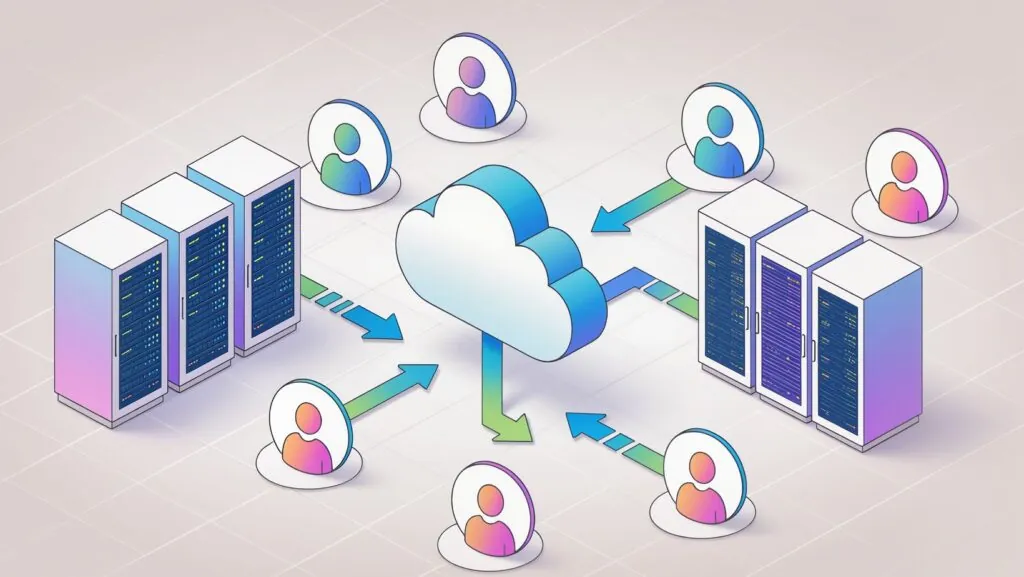Table of Contents
ToggleThat familiar feeling is creeping in. The server rack in the corner is aging, warranties are expiring, and the calendar is marked for the next big, disruptive hardware refresh. It’s a cycle of massive capital expense, weekend-long migrations, and resource drain that every IT manager and business owner dreads. You’re not just buying new servers; you’re buying into another five years of the same operational burdens.
But what if this upgrade could be your last? The conversation around IT infrastructure has fundamentally changed, driven by a relentless focus on financial efficiency. According to CloudZero, “78% of organizations are making cloud cost optimization their top priority in 2025”, as most companies aim to reduce waste and gain better cost visibility. This article explores why your next upgrade shouldn’t be another hardware purchase, but a strategic shift to managed cloud services—a move that transforms your IT from a cost center into a flexible, powerful business enabler.
Key Takeaways
- Traditional server hardware refreshes drain capital (CapEx) and operational budgets (OpEx) while hindering business scalability.
- Modern businesses are moving from hardware ownership to managed cloud services, transforming large capital expenditures into predictable operational costs.
- Alternatives like serverless computing and managed private cloud offer scalable, secure, and efficient solutions that replace on-premise infrastructure.
- Partnering with an expert cloud provider enables financial agility, increases operational efficiency, and future-proofs your IT for emerging technologies.
The Vicious Cycle of On-Premise Infrastructure
Why “Business as Usual” is Holding You Back
For years, the three-to-five-year server refresh was simply the cost of doing business. But in today’s fast-paced digital economy, this “business as usual” approach has become a significant liability. The cycle is more than just an inconvenience; it’s a financial and operational drain that actively holds your business back.
High Capital Expenditure (CapEx) – The most obvious pain is the massive upfront cost. A full infrastructure refresh requires significant capital for servers, storage arrays, networking gear, and the associated software licenses. This large outlay strains budgets, ties up cash flow, and forces difficult financial trade-offs that could otherwise be invested in growth.
The Maintenance Tax – The purchase price is just the beginning. On-premise hardware comes with a hidden “maintenance tax” of ongoing operational costs (OpEx). This includes the ever-increasing costs of power and cooling, the physical security of your server room, recurring software license fees, and the countless hours your skilled IT staff spend on patching, updates, and troubleshooting hardware failures.
Scalability Roadblocks – Traditional infrastructure is rigid. If your business experiences a sudden surge in demand, you can’t instantly add more capacity. This leads to performance bottlenecks and frustrated customers. The common workaround is to overprovision—buying more hardware than you currently need—which means you’re paying to power and maintain resources that sit idle most of the time.
The Expertise Burden – Managing a complex on-premise environment requires a specialized skill set. Hiring, training, and retaining top-tier IT talent is a constant challenge. This often means your best people are stuck “keeping the lights on” instead of focusing on strategic projects that drive real business value.
This relentless cycle of high capital expenditure, resource-draining maintenance, and scalability ceilings is precisely why businesses are fundamentally rethinking their infrastructure strategy. Instead of owning and operating hardware, they are moving to a fully managed service model.
This approach allows them to partner with experts such as a cloud services provider, who handle the complexity of designing, deploying, and supporting a high-performance environment, turning a capital expense into a predictable operational one—making it a critical first step toward modernizing IT operations.
The Modern Alternative: From Owning Boxes to Consuming Services
The solution to breaking the hardware refresh cycle is a fundamental paradigm shift: stop thinking about owning boxes and start thinking about consuming services. This is the core principle behind the “as-a-service” model.
Imagine your IT infrastructure working like your electricity or water utility. You don’t own the power plant or the reservoir; you simply pay a predictable monthly bill based on your consumption. The cloud applies this same logic to computing resources. You access the processing power, storage, and networking you need, when you need it, without ever owning the underlying physical hardware.
This move fundamentally changes your financial model, shifting IT spending from capital expenditure (CapEx) to operational expenditure (OpEx). Instead of large, unpredictable capital outlays every few years, you have a clear, predictable monthly cost. This improves cash flow, simplifies budgeting, and makes your business more financially agile.
There are different ways to make this shift, but two key approaches stand out for businesses looking to stop buying servers:
- Serverless Computing: In this model, the underlying server infrastructure is completely abstracted and managed by the cloud provider. You only need to worry about your application code.
- Managed Cloud Infrastructure (IaaS/Private Cloud): Here, your business gets dedicated, high-performance server resources, but a specialized provider like 24x7IT owns, manages, and maintains all the hardware, networking, and data center operations.
The best path forward isn’t “one size fits all.” It’s about selecting the right blend of managed services to meet your specific security, performance, and application needs.
A Deeper Look at Your Options
Choosing to consume IT as a service opens up powerful new possibilities. Let’s explore the two primary strategies that allow you to leave the hardware lifecycle behind for good.
What is Serverless Computing, Really?
Serverless computing doesn’t mean there are no servers; it just means you don’t have to think about them. The core concept is that your application code runs on-demand in response to specific events or triggers. The cloud provider automatically handles all the provisioning, scaling, and management of the underlying server infrastructure.

This approach offers transformative benefits for the right workloads:
- Automatic Scaling: The environment scales instantly and automatically to handle anything from a few requests to thousands per second.
- True Pay-Per-Execution Pricing: You are billed only for the precise moment your code is running, down to the millisecond. If no one is using your application, you pay nothing.
- Developer Focus: Your development team can focus purely on writing application logic that delivers business value, not on server administration.
This isn’t a niche trend; it’s a rapidly expanding market. According to Grand View Research, “the global serverless computing market size was estimated at USD 24.51 billion in 2024 and is projected to reach USD 52.13 billion by 2030”, growing at a remarkable rate. Its adoption is mainstream, with Datadog reporting that “over 70 percent of AWS customers and 60 percent of Google Cloud customers currently use one or more serverless solutions”.
The Power of Managed Private Cloud
While serverless is ideal for event-driven applications, most businesses rely on core systems—like databases, ERPs, and legacy applications—that require dedicated, high-performance resources. This is where a managed private cloud shines.
In simple terms, a managed private cloud gives you all the benefits of having your own secure and powerful server environment, but without any of the burdens of ownership. A provider like 24x7IT owns and operates the enterprise-grade hardware in a secure data center, giving you dedicated access to the computing resources you need.
This model is designed to solve the biggest challenges of on-premise infrastructure:
- Enhanced Security and Compliance: Your resources are isolated in a private environment, giving you greater control over security configurations to meet strict compliance requirements like HIPAA or PCI.
- Predictable High Performance: Critical applications get the dedicated CPU, RAM, and storage they need to run without interruption or competition from other users.
- Easier Migration Paths: It’s often much simpler to move existing and legacy applications to a managed private cloud than to re-architect them for a public cloud platform.
- Predictable Operational Costs: You get a clear, fixed monthly cost for your infrastructure, eliminating surprise expenses.
Furthermore, a partnership with 24x7IT provides unique value, including 24x7x365 expert support to ensure operational continuity and flexible short-term contracts that reduce long-term financial risk and commitment.
The Transformative Business Benefits
More Than Just Cost Savings
Moving away from hardware ownership delivers strategic advantages that ripple across the entire organization. The benefits go far beyond simply avoiding the capital expense of a server refresh.
- Financial Agility: By eliminating large CapEx outlays, you smooth out cash flow with predictable OpEx. This allows you to pay only for the resources you truly consume, optimizing budget allocation and freeing up capital for strategic investments in growth.
- Radical Scalability: You gain the immediate ability to scale IT resources up or down to adapt seamlessly to business demand. Whether you’re handling seasonal spikes, launching a new product, or accommodating rapid growth, your infrastructure can now expand or contract in minutes, not months.
- Increased Operational Efficiency: Free your internal IT team from the tedious, time-consuming tasks of patching, monitoring, and troubleshooting hardware. This allows them to pivot from “keeping the lights on” to focusing on high-impact, strategic initiatives that drive innovation and generate revenue.
- Future-Proofing Your Business: As an observed industry trend, flexible cloud platforms serve as a robust foundation for adopting emerging technologies. You can experiment with and deploy Artificial Intelligence (AI), Machine Learning (ML), and Internet of Things (IoT) applications without needing to invest in specialized, expensive on-premise hardware.
Your Last Upgrade is a Strategic Shift, Not a Purchase
“Stopping buying servers” doesn’t mean your business stops needing powerful, reliable, and secure IT resources. It means you finally stop carrying the immense financial and operational burden of owning and managing the physical hardware yourself. The endless cycle of purchasing, maintaining, and replacing equipment can, and should, come to an end.
The future of smart IT infrastructure is not about ownership; it’s about consumption. It involves forming a strategic partnership with a managed services provider who can expertly design, implement, and support the right blend of cloud solutions tailored to your specific business goals. This is more than just an upgrade—it’s a fundamental shift in how you power your business.




